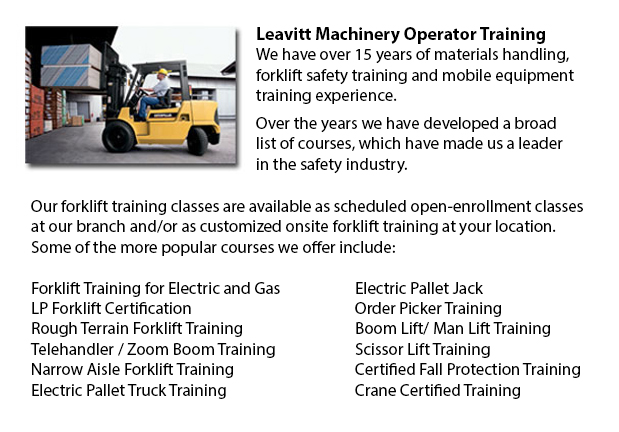
Grande Prairie Forklift Training School - Why A Forklift Operator Must Take A Forklift Training School - OSHA and CSA establish criteria for forklift safety training that meets current regulations and standards. Anyone planning to operate a forklift is needed to successfully complete safety training prior to making use of whichever type of forklift. The accredited Forklift Operator Training Program is intended to provide individuals training with the information and practical skills to become an operator of a forklift.
Vehicle and Mobile Equipment safety regulations which apply to forklift utilization involve pre-shift inspections, and rules for loading and lifting.
An inspection checklist should be carried out and submitted to the supervising authority before beginning a shift. When a maintenance problem is uncovered, the use of the particular machinery should be discontinued until the issue has been dealt with. To indicate the machine is out of order, the keys should be removed from the ignition and a warning tag placed in a visible spot.
Safety regulations for loading will consist of checking the forklift's load rating capacity to determine how much the machine could handle. When starting the machinery, the forks should be in the downward position. Bear in mind that there is a loss of roughly 100 pounds carrying capacity for every inch further away from the carriage that the load is carried.
Lifting must begin with the driver moving to a stopped position approximately three inches from the load. The mast should then be leveled until it has reached a right angle with the load. Raise the forks to an inch below the slot on the pallet and drive forward. Next lift forks four inches. Tilt back the load to be able to secure it for moving. Drive the lift in reverse if the load obscures frontal vision. Check behind and honk to alert other staff. Do not allow forks to drag on the ground.
-
Grande Prairie Overhead Crane Safety Training
Grande Prairie Overhead Crane Safety Training - Overhead crane safety training equips operators with skills and knowledge about crane safety measures, accident avoidance, materials handling, and machine and stock protection. Trainees will learn the k... More -
Grande Prairie Crane License
Grande Prairie Crane License - The crane operator needs to have been certified with a crane operator license or certification. To be able to practice as an operator of a crane, the qualifications are considered mandatory. Obtaining a license includes... More -
Grande Prairie Heavy Equipment Training
Grande Prairie Heavy Equipment Training - The two most common types of heavy equipment training are classed into the categories of machines; equipment which is fashioned with rubber tires or those with tracks. The tracked vehicle are heavy duty machi... More -
Grande Prairie Skid Steer Ticket
Grande Prairie Skid Steer Ticket - On a skid-steer loader, the lift arms are beside the driver along with pivot points at the back of the driver's shoulders. This makes them different compared to a conventional front loader. Because of the operator's... More -
Grande Prairie Zoom Boom Ticket
Grande Prairie Zoom Boom Ticket - Zoom Boom Training is intended to train operators on variable reach forklifts. The objectives of the training are to impart an understanding of the physics of the equipment, and to be able to outline the operator's t... More -
Aerial Lift / Boom Lift / Man Lift / Scissor Lift Certification in Grande Prairie
Scissor lifts are lift truck tables that raise materials and people and supplies vertically. They are usually used in commercial, industrial and construction environments. A common use of scissor hoists is for lifting or lowering construction supplie... More -
Grande Prairie Aerial Lift Safety Training
Grande Prairie Aerial Lift Safety Training - Each and every year, there are roughly 26 construction fatalities due to the utilization of aerial lifts. Most of the craftsmen killed are laborers, electrical workers, ironworkers, carpenters or painters.... More -
Grande Prairie Fall Protection Ticket
Grande Prairie Fall Protection Ticket - The number one reason of death within the construction business come from fall-related incidents. There is more chance for fall accidents depending upon the kinds of work being done in your workplace. Therefore... More

Forklift Certification Grande Prairie
TOLL FREE: 1-888-254-6157
Grande Prairie, Alberta
forkliftcertificationgrandeprairie.com
Email Us
About Us


